by Reuben Holt // Sept. 5, 2023
Billy Bultheel is a composer focusing on site-specific projects that straddle the boundaries between sculpture, installation and performance art. While Bultheel splits his time between Brussels and Berlin, the artist’s new performance and sound installation, ‘The Thief’s Journal,’ is set to be premiered on September 14th at Kraftwerk, the former East Berlin power plant and performance venue. Taking place within the venue’s 100 metre-long turbine hall, the event is part of Atonal, the city’s annual festival for sonic and visual art. We spoke to Bultheel about the use of space as a guiding principle in his compositions and how these play out in his upcoming show at Kraftwerk.
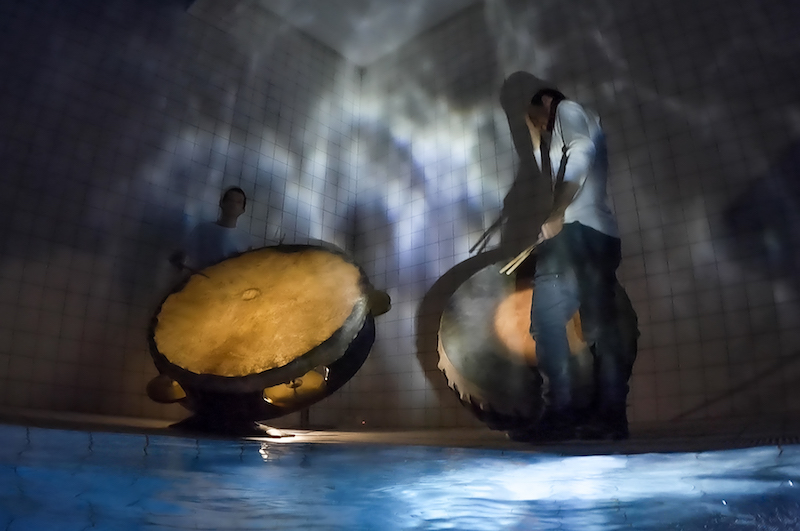
Billy Bultheel and Tanya Viviana Abelson: ‘Unter,’ 2022, Spreewaldbad Berlin, ‘Disappearing Berlin’ in collaboration with radialsystem // Photo by Thyago Sainte, courtesy of Schinkel Pavillon
Reuben Holt: How would you describe your work to someone who’s never experienced it before?
Billy Bultheel: I work between music and performance and installation. I want the listener or the spectator to embed themselves within a kind of spatial composition. These pieces are often performed by musicians playing live music in combination with electronics or pre-recorded material. I’ve done a lot of research into European medieval and early Renaissance music. A lot of my music borders on these kinds of sacral approaches but seen through a contemporary or more industrial scope.
RH: Whether a Renaissance church or an ancient Greek amphitheater or, in the case of Atonal, a disused power plant, the venue appears to play an integral role in shaping your composition process. How does the physical space guide your decisions?
BB: I always say space is the first step or the first compositional factor. In the case of Atonal, we’re actually building an architecture within Kraftwerk, which is very much inspired by the psychoacoustic effects of Renaissance architecture, especially churches. In this case, we are working with the scenographer Andrea Belosi. Together, we’ve built a pulpit above the audience, a platform from which the priest would lecture in church, which reflects the sound back onto the people. Normally, I’m trying to work with the resonances of an already existing space, while in this case we’re manipulating them.
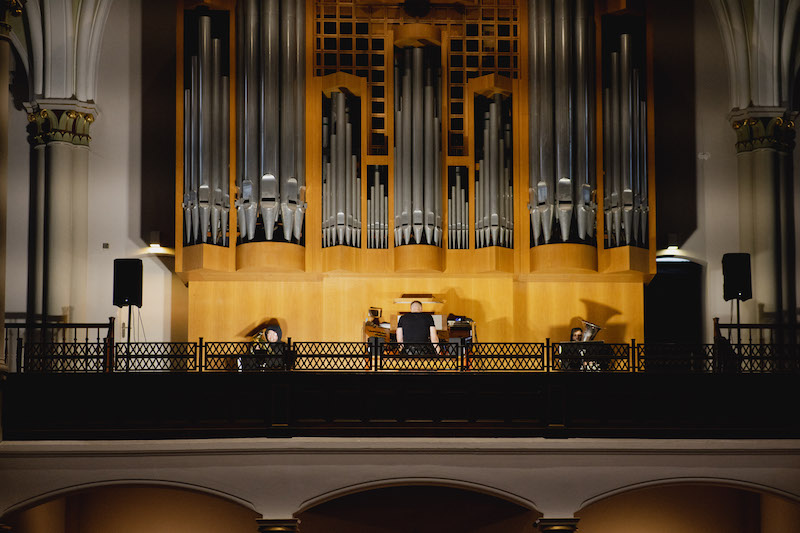
Billy Butheel: ‘Shadow Tracks,’ 2022, CCA 4 Seasons II // Photo by Peter Oliver Wolff, courtesy of CCA
RH: Collaborations have featured very prominently in your career. Were there any projects in particular that marked a turning point for you?
BB: Yeah, many. Most famously my collaborations with Anne Imhof. We started working together when we were still in school and then have moved very quickly through all these big institutions like the Venice Biennale, The German Pavilion. We had a very intense collaborative exchange, which has definitely shaped a lot of the things I do. I have a new collaborative project that I just started with the artist James Richards. It’s a performance for video and live music. I am really stepping outside of my comfort zone in this one. I think he has never really done performance before so that’s a first for him and interestingly for me it’s the first time working with existing images. I think that we both really wanted to start using text and poetry and so embracing these new media in our work has been a very challenging but extremely eye opening experience—for me, at least.
We are actually performing it in Brussels now, the week before Atonal. Then it’s coming to Berlin to KW sometime in June next year. And probably in early November this year I’m releasing my first album on PAN Records, which is called ‘Two Cycles: Snow Cycle and Game Cycle.’ It will have a lot of the compositions that are in the Atonal performance, so that’s really exciting for me. It’s the first time. I mean, it’s the fourth record that I’m releasing but it’s the first one that is under my own name.
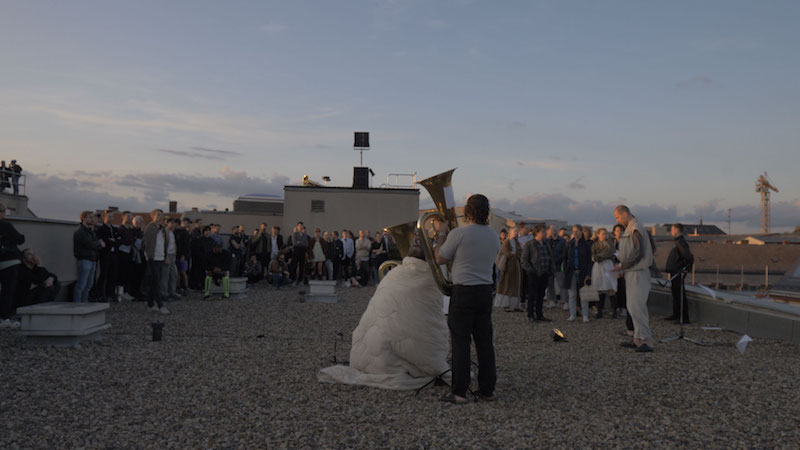
Billy Bultheel and Spyros Rennt: ‘When Doves Cry,’ curated by Joel Mu, Bonjour Tristesse, Disappearing Berlin // Photo by Agustin Farias, courtesy of Schinkel Pavillon
RH: As both a choreographer working with dancers and a composer working with musicians (sometimes at the same time), do you see any similarities in the process?
BB: Yes, it’s actually through studying dance and working with dancers that I feel like my work has developed with musicians. I always found that choreographers have such a freedom in how they relate to the people that can perform their work, the dancers. There’s always a lot of elements of improvisation that come into play. It’s a much more collaborative live exploration of material, the way that choreographers work with dancers. With composers, a sheet of music scores separates the composer and the musician. The composer would write down his thoughts on paper and then the musician would interpret what has been written down and somehow it kills the direct communication between the composer and the performer.
There’s this myth that musicians, especially, you know, classically trained musicians, just want to be dressed in black and disappear behind their instrument. But actually that’s not really true at all. I feel the moment that you frame them within a performative setting they are actually very happy to perform and to become bearers of their own expressive qualities.
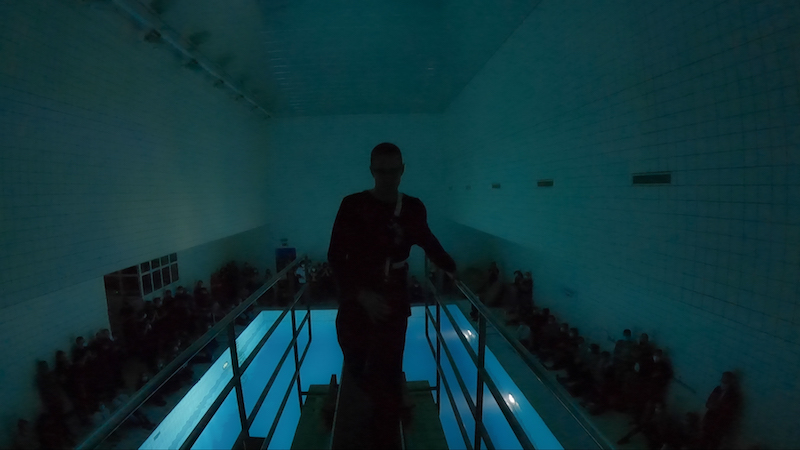
Billy Bultheel and Tanya Viviana Abelson: ‘Unter,’ 2022, Disappearing Berlin in collaboration with radialsystem, Spreewaldbad Berlin // Photo by Thyago Sainte, courtesy of Schinkel Pavillon
RH: A common thread through your work is allowing the audiences the freedom to move through the action and experience it from different perspectives, different parts of the room. Is this a guiding principle for you?
BB: I have this memory of an experience that I had when I started studying in the conservatory. You would walk through the wing of rehearsal rooms. So you’d just walk by all of these different rooms and you’d hear everyone rehearsing these very complex pieces of music. And there was just something so beautiful about witnessing people engaging with music but not necessarily performing it to an outside audience. Rather, I could move around and just witness a stranger engaging in this process and having this much more intimate relationship to music. I think that’s something that I always try to recreate in my pieces.
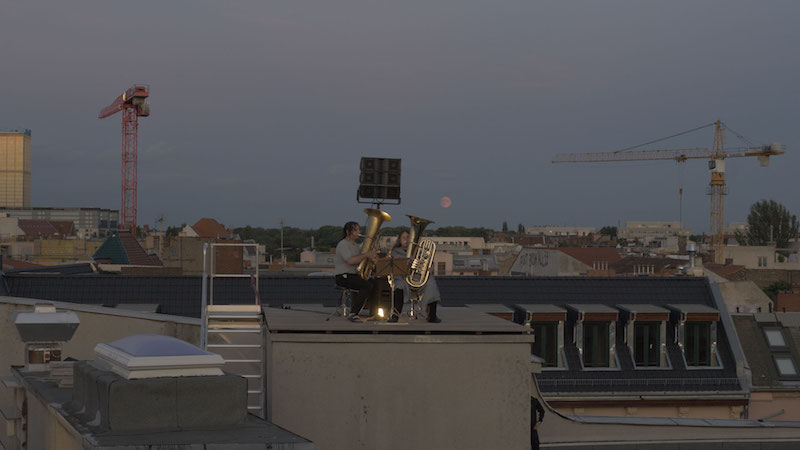
Billy Bultheel and Spyros Rennt: ‘When Doves Cry,’ curated by Joel Mu, Bonjour Tristesse, Disappearing Berlin // Photo by Agustin Farias, courtesy of Schinkel Pavillon
RH: What kind of impact do you think the audience’s behavior has on the evolution of your work?
BB: It depends how free the audience is to move. How close they’re getting, how rowdy they get. This is something that was also a very important aspect in my work with Anne [Imhof]. I remember performing at the German Pavilion (in Venice). People would get really frustrated because they would stand in line for such a long time. But then they would start, at some point, literally touching the performers, attacking the performers. We had to engage security to calm people down and have them behave in the space. It can go really wrong. The frustration almost becomes part of the performance.
I think having that element of risk is actually what keeps it fresh so yeah, it obviously influences the performance a lot. It also keeps the performers on their toes.
Exhibition Info
Berlin Atonal 23
Group Show: ‘Universal Metabolism’
Performance ‘The Thief’s Journal’ by Billy Bultheel: Thursday, Sept. 14; 9pm
Concert by Billy Bultheel: Friday, Sept. 15; 7:15pm
Exhibition: Sept. 11–14, 2023
berlin-atonal.com
Kraftwerk Berlin, Köpenicker Straße 70, 10179 Berlin, click here for map




















